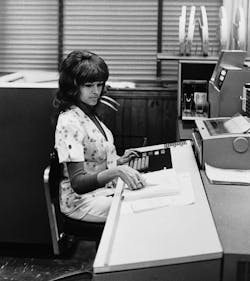Sponsored
As part of our celebration of Electrical Wholesaling magazine’s upcoming 100th anniversary in April 2020, we will be reflecting on —and occasionally poking a little fun at — some of our feature articles that have been published over the years. In a Jan. 1985 Electrical Wholesaling article entitled “A Walk Through the Office of Tomorrow,” we looked 15 years into the future and sketched out what an office might look like in the year 2000.
Looking back 34 years, our vision from back then has emerged with several dents and dings in it, along with a few moments of crystal clarity. We nailed how computers would help the business world streamline operations by making it super easy to share data, but our vision for the type of computer equipment that would do it and the capacity computers would have were way off the mark. Following is some of the dialog we conjured up back in 1985 for when a customer gives a distributor salesperson a tour of his office of the future, and some present-day commentary on the accuracy of our predictions.
Your smart phone probably has as much computing power as this work station.
Score a point for sketching out a rudimentary scheme for sharing data over a Local Area Networks (LANs).
“These computer terminals are all connected together into what they call a ‘local area network.’ This lets each of them share the information my people are programming into them. Say a salesman closes a deal. His secretary types in the job specifics — you know, size of job, where it is, the contact, company address — on the computer keyboard and then enters all this information on the memory file.
“The key thing is that the memory file is shared by all of the company’s departments. Accounting needs the information for billing. Corporate can call on it for progress spot-checks. Marketing can call on it to check on a trend. It makes the whole scheme of things work smoother than the way we had our computer system set up before, where each department had to go through the interoffice mail, phone calls, the whole bit, just to get the same information on each account. It also saves us money on some of the computer peripheral equipment, like printers and hard disk storage, because each department doesn’t have to have its own equipment. A couple of departments can share the same stuff.”
The type of job data various departments might need and the need to share this information as sketched out in this scenario still exists to this very day, and the idea for how the customer uses the LAN to connect various departments isn’t too far off from today.
Deduct a point for vastly underestimating the storage capacity of office computers.
“We do all of our records storage in each of these dinner-plate-sized storage disks. Each disk holds up to 40,000 letters. All we have to do to file a letter is to run it through this copier. A laser scanner then commits it to the disk’s memory. This system really cleans up our bulk filing. We figure that our 32 disks take the place of 55 full, four-draw filing cabinets.”
Oops… The 40,000 letters (or documents being stored on each of these “dinner plate-sized storage disks” could now fit easily onto two 16GB USB thumb drives, according to swww.cfgearblog.blogspot.com. Each thumb drive costs well under $10. And the whole idea of letters as the main means of business correspondence now seems archaic. Email started replacing many typewritten letters in the mid-1990s, when AOL, Prodigy, and CompuServe were launched.
An “attaboy” for seeing the value of mobile telephones, but a “noogie” for conjuring up the “data generator.”
“All of my outside salespeople can be in immediate contact with me, wherever they are in the country or the world, whether they are in the office or not. They all have telephones and data generators in their cars, so they can either call me or send documents that must be here pronto.
“We have a similar link at our bigger construction projects. We are tied in via cellular telephone and a data link from the construction sites. If the foreman needs materials that day, he punches the info into an on-site computer terminal. A printout is generated in seconds in the warehouse and we try to get the materials out on their way to the job site that day.”
We were surprised to see a 34-year-old reference to cellular telephones, but don’t know quite what to make of this “data generator” thing. Cellular telephones have certainly taken on any of the data generating capabilities we saw back in 1985.
Delusions of grandeur for undercarpet wiring systems.
“We use undercarpet wiring for our power and telephone wiring systems. It gives us the flexibility we need to move our work stations or equipment around.”
Back in the 1980s, I was fascinated by undercarpet wiring and enjoyed getting out on jobsites to see it installed — including in a bank vault on Wall Street. You can still find information on flat conductor wiring systems out on the internet and some distributors apparently still stock it, but it has not yet become as popular as I expected.



